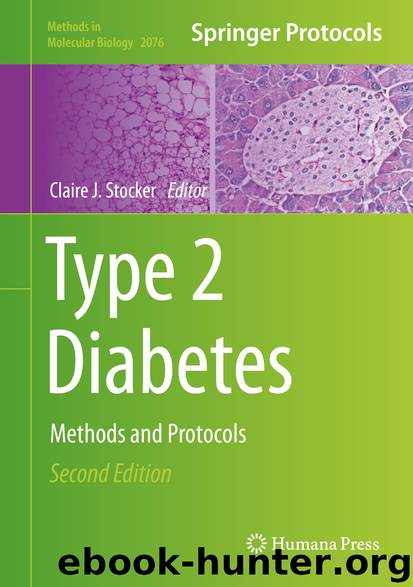Type 2 Diabetes by Claire J. Stocker

Author:Claire J. Stocker
Language: eng
Format: epub
ISBN: 9781493998821
Publisher: Springer New York
Key words
Pathway analysisMetabolic pathwayGene expressionType 2 diabetesMicroarray
1 Introduction
Genome-wide transcriptional profiling techniques provide researchers with tools to explore life at the molecular level by quantifying temporal and spatial changes in gene activity. However, meaningful analysis of complex data generated by these techniques remains a challenge despite recent substantial efforts to develop sophisticated analysis methods. Pathway enrichment is one of these analysis methods that have facilitated our understanding of big genetic data by reducing the dimensionality of analyzed data from tens of thousands of individual genes into hundreds of predefined biological pathways curated and stored in public databases [1]. Based on differences in structure and mechanism, biological pathways are grouped and stored in different categories such as biochemical enzyme–substrate pathways, linear or branching signaling cascades pathways or protein–DNA binding. Therefore, defining a one-size-fits-all set of mathematical principles to analyze different groups of pathways is a very challenging task. Pathway enrichment approaches can be generally divided into three generations [2]: Over-Representation Analysis (ORA), Functional Class Scoring (FCS) approaches, and Pathway Topology (PT)-based approaches (Fig. 1). Arguably, the third-generation approaches outperform both ORA and FCS approaches in the rational exploitation of rich biological information such as topology of pathway represented by genes location and interaction (e.g., activation, inhibition, etc.). Several topology-based pathway enrichment tools have been proposed in the literature over the past few years [2]. Some tools rely on topology only in scoring pathways [3, 4], whereas others use topology in addition to other gene expression measurements [5].
Fig. 1Pathway enrichment analysis approaches (Adapted from [2])
Download
This site does not store any files on its server. We only index and link to content provided by other sites. Please contact the content providers to delete copyright contents if any and email us, we'll remove relevant links or contents immediately.
| Administration & Medicine Economics | Allied Health Professions |
| Basic Sciences | Dentistry |
| History | Medical Informatics |
| Medicine | Nursing |
| Pharmacology | Psychology |
| Research | Veterinary Medicine |
Tuesdays with Morrie by Mitch Albom(4690)
Yoga Anatomy by Kaminoff Leslie(4306)
Science and Development of Muscle Hypertrophy by Brad Schoenfeld(4089)
Bodyweight Strength Training: 12 Weeks to Build Muscle and Burn Fat by Jay Cardiello(3913)
Introduction to Kinesiology by Shirl J. Hoffman(3725)
How Music Works by David Byrne(3187)
Sapiens and Homo Deus by Yuval Noah Harari(2987)
The Plant Paradox by Dr. Steven R. Gundry M.D(2547)
Churchill by Paul Johnson(2506)
Insomniac City by Bill Hayes(2497)
Coroner's Journal by Louis Cataldie(2432)
Hashimoto's Protocol by Izabella Wentz PharmD(2331)
The Chimp Paradox by Peters Dr Steve(2297)
The Universe Inside You by Brian Clegg(2097)
Don't Look Behind You by Lois Duncan(2080)
The Immune System Recovery Plan by Susan Blum(2027)
The Hot Zone by Richard Preston(1983)
Endure by Alex Hutchinson(1964)
Woman: An Intimate Geography by Natalie Angier(1882)
